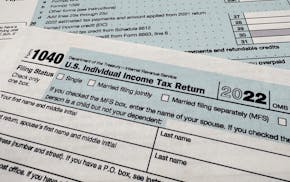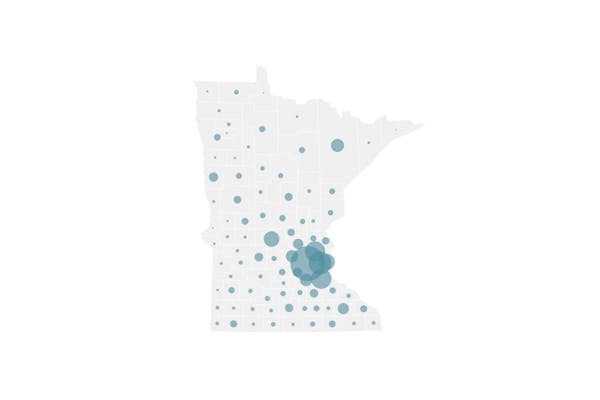Three major COVID-19 models predict sharp declines in viral spread in Minnesota in late May — with Mayo Clinic forecasting a drop from 900 new infections per day to 563 by Memorial Day weekend.
The forecasts come amid a decline to 5.7% in the positivity rate of diagnostic testing in the state and a drop in COVID-19 hospitalizations in Minnesota from a peak of 699 on April 14 to 423 on Sunday.
The models forecast a decline to what will likely be a stable level of transmission of the SARS-CoV-2 coronavirus that causes COVID-19, rather than an end to the pandemic, said Dr. Sean Dowdy, Mayo's deputy chief value officer and a co-creator of the health system's model.
"We have spent too much time discussing the extreme ends of the spectrum — a massive surge that overwhelms our medical system vs. herd immunity and disappearance of the virus," Dowdy said. "In all likelihood our future will be somewhere in between, where serious disease is uncommon enough that our hospitals will continue to function safely ... but herd immunity will not be achieved."
Other positive forecasts for Minnesota come from the Institute for Health Metrics and Evaluation (IHME) in Washington state and the federal Ensemble model that aggregates predictions from more than 20 different national COVID-19 models.
State health officials have characterized the latest pandemic wave as a race between COVID-19 vaccinations and the spread of more infectious SARS-CoV-2 variants.
Vaccination progress has slowed, but the state on Monday reported that more than 2.7 million people have received at least a first dose of COVID-19 vaccine and that more than 2.3 million of them have completed the one- or two-dose series. Nearly 62% of Minnesotans 16 and older have received at least a first shot — with the Pfizer version of the vaccine being offered last week for the first time to people 12 to 15.
The state on Monday reported no COVID-19 deaths and 589 more infections identified through testing — lowering the seven-day average of daily reported infections to 866. Minnesota's totals in the pandemic are 7,296 deaths and 595,016 known infections.
State health officials last week said they will be closely watching for the impact that any reduction in prevention strategies has on the variant vs. vaccine race.
Gov. Tim Walz ended the state's public indoor mask mandate late last week, though some municipalities and businesses still require that masks be worn to reduce risks of viral transmission. Target removed its mask requirement on Monday, while signs at the Mall of America only strongly encourage that they be worn.
Mask usage had already been declining before the change in state policy, with IHME publishing survey data showing that only 68% of Minnesotans always wear their masks in public right now. The mask-wearing rate had been above 70% in Minnesota since Oct. 22, but IHME predicts it will fall below 60% by June 2.
Local mask-wearing ordinances are in effect in Minneapolis and St. Paul, where local public health leaders said they are needed to reduce viral transmission and protect people who have yet to be vaccinated. Equity data shows vaccination rates lagging in some ZIP codes that have higher poverty rates or more minority groups at elevated risk of severe COVID-19 illness.
Test positivity rates for COVID-19 are lower in Minneapolis and St. Paul than in the state overall, said Kathy Hedin, deputy county manager of health and wellness for Ramsey County. "We do feel that is because of the amount of people that are wearing masks in our cities and it does play a role in helping to keep people safe, in helping to keep COVID rates down. Until we can get that vaccination rate higher, one of the ways to help keep people safe is to keep a mask on."
Hedin on Tuesday morning will address the Ramsey County Board regarding the existing mask requirement inside county-owned facilities. Leaders of the St. Paul-Ramsey, Hennepin County and Minneapolis public health agencies are discussing common standards to use regarding vaccination equity targets and when to change the mask guidance in the two cities.
Masks and other strategies such as social distancing and staying home when sick have also severely curtailed seasonal influenza. Minnesota has reported 38 flu-related hospitalizations and five deaths so far for the 2020-2021 season — compared with 4,022 hospitalizations and 197 deaths in the 2019-2020 flu season.
The state is scheduled to remove remaining indoor capacity caps and social distancing requirements on restaurants and entertainment venues on May 28 before the Memorial Day weekend.
The latest weekly summary of social COVID-19 outbreaks in Minnesota showed a total of 326 outbreaks in bars and restaurants so far this year. Outbreaks in these settings are defined as seven people from different households having positive COVID-19 tests and visiting only the same bar or restaurant in the past month.
While there can be a time lag in the identification of group outbreaks, the numbers appear to be declining. The number of bar/restaurant outbreaks peaked this year at 50 in the seven-day period ending April 10 but declined to 22 identified so far in the week ending May 8.
Jeremy Olson • 612-673-7744
New Minnesota GOP leaders seek peace with party's anti-establishment wing

Who is Republican Lisa Demuth, Minnesota's first House speaker of color?

Minnesota House GOP, Secretary of State Steve Simon return to Supreme Court
Supreme Court sides with DFL and Simon, says 68 House members needed for floor action

